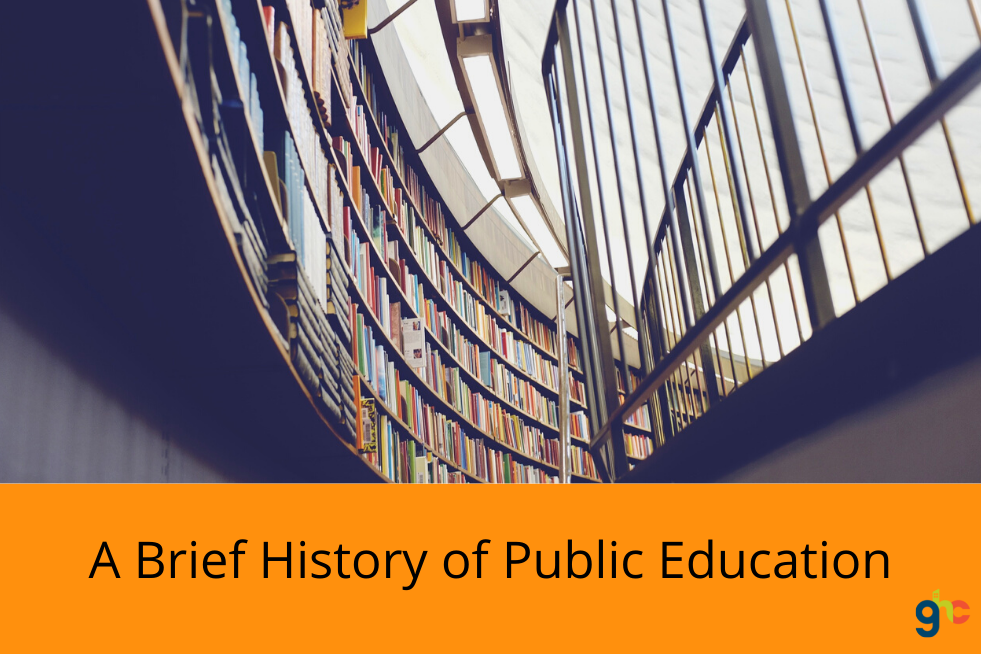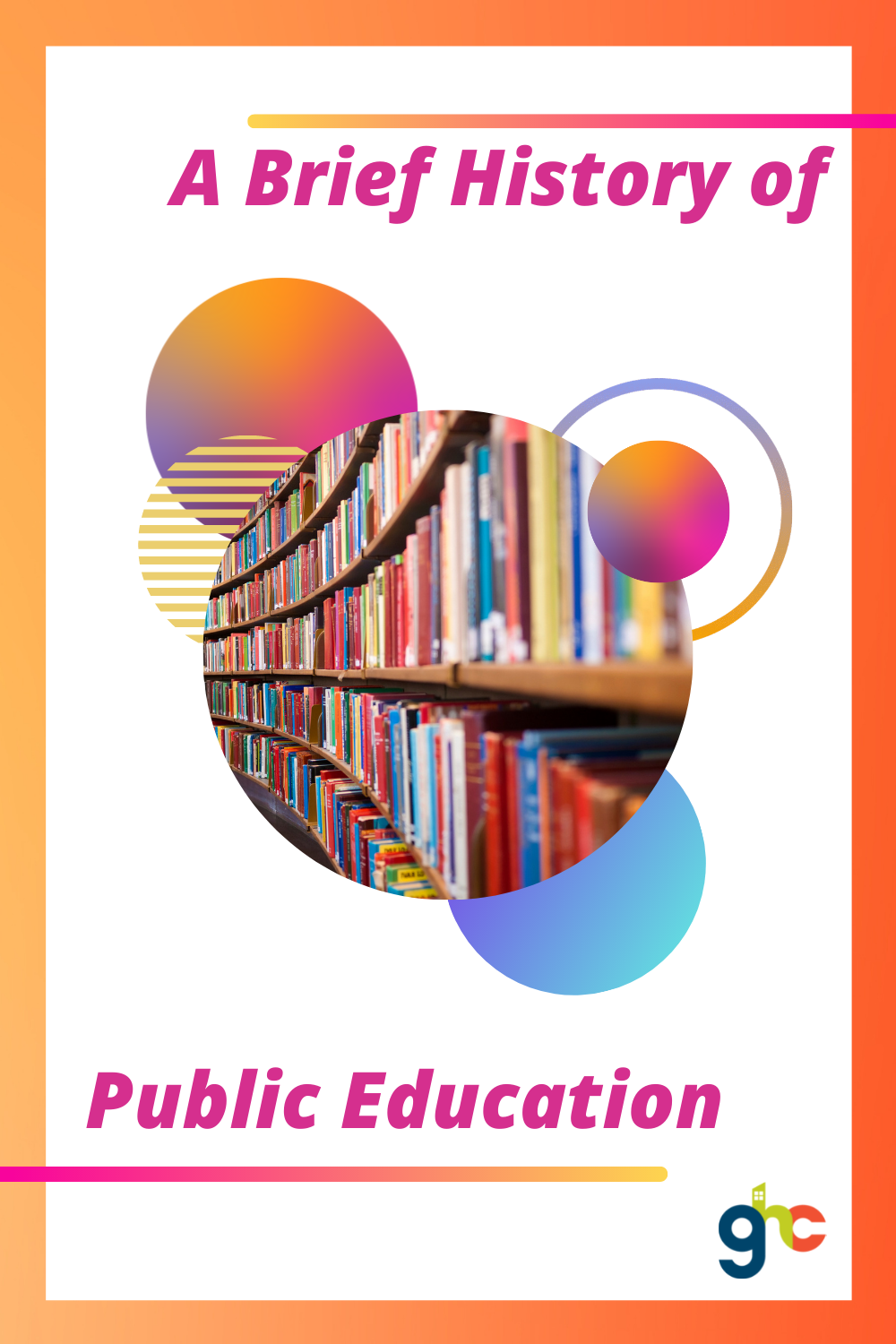These days, it seems like the public education system simply always was, but that’s not entirely true. It’s a routine that many know as “forced schooling,” and what better term for it? Think of the actual necessity of six or more classes each day, Monday through Friday without fail, at least nine months out of the year, for twelve formative years out of every human life. Breaking it down that way and then attaching a word like “necessary” seems a bit foolish if you really think about it. Is it really necessary? And if so, why? Whereas there are vague “reasons” attached to the idea of mass public education programs, it doesn’t make much sense even if you attempt to take it at face value.
Of course, the option to agree or disagree with this kind of “necessity” was taken away when public school was made mandatory and laws were passed to assure us that, yes, we do in fact need it.
The idea of public school, or mass government schooling, was conceived many years ago, but we actually see it finally take root in America around 1905 and shortly thereafter. There are three main reasons “they say” this kind of factory schooling is necessary, even though it uprooted family life as it was then known. It also uprooted almost every single cultural tradition of the era and marginalized females, Native Americans, people of color, and those that did not speak English.

The first “reason” they cite in the great necessity and moral obligation of public school is to make good people. As if government schooling were the only real and reasonable means of steering human nature toward that goal.
The second “reason” is to make good citizens. This is to say that without public schooling, good citizens would not be a possibility in the first place. How much sense does that make? Whereas that may be true much of today’s society, I doubt it was entirely true in those early days! At least, enough to warrant the complete restructuring of family life to make room for institutionalized teaching farms.
And the third “reason” is to turn each person into the very best they can be. Again, that assumes that people are, without mass schooling, bad people at the very core, imposing public school as society’s only hope for a population that cares to be their very best. But we know that to be false.
Public Education in Colonial America
History, as we know it, shows what looks to be a bright beginning. The very first American educational system came into existence in New England in the early to mid-1600s and, even then, they were funded by tax dollars. The very first “compulsory” schooling came about in 1642, via the Massachusetts Bay Colony. At this point in history, the majority of the student body was male, with a few considerations made for females, though in an entirely different building. They were also all Caucasian. By the eighteenth century, more and more schools were available, there was great age diversity among the students. Stille, however, this education was not tuition-free. Parents were charged for the education of their children.
It’s interesting to note that even in those early days, only the very rich and elite homeschooled their children. Others made use of public schools, private schools, and special parochial schools based on religious affiliation. Of course, there were no charter schools or school vouchers to even be considered. An attempt was made forcibly to educate the Native Americans, but the man who spent two years as the deputy of that school was slaughtered in the Indian Massacre of 1622. His name was George Thorpe.
The first all-girls school was the Ursuline Academy, a Catholic school founded in 1727. The first female pharmacist was a graduate of Ursuline. It was also the first free, non-profit organization, the first ever to teach women of color, the first to teach female slaves, and the first to teach Native Americans. This school gave way to more public girls’ schools by 1767, which were supported by taxes. Changes were made, however, when the elite from the highest social structures of the day refused to allow their tax dollars to aid public school students who were poor.
As time went on, other schools opened that cater to the population that did not speak English. Primarily Dutch and German, the schools that were organized during this time were primarily for the purpose of educating for the purpose of reading Scripture. By 1840, half the population (nearly 4 million at that time) was between the ages of five and fifteen and showed enrollment in some type of school year.
Educational Reform and Public Education
By 1837, a man named Horace Mann had become the secretary of education in the state of Massachusetts. He believed in the Prussian Model of schooling and heavy focus was placed on training both students and teachers, each in their own place. From there, the first law regarding compulsory attendance was passed in 1852.
According to Ellwood P. Cubberley, who was a particular fan of Mann’s work in education, had this to say:
“No one did more than he to establish in the minds of the American people the conception that education should be universal, non-sectarian, free, and that its aims should be social efficiency, civic virtue, and character, rather than mere learning or the advancement of sectarian ends.” (“Public Education In The United States : Cubberley, Ellwood. P : Free Download, Borrow, and Streaming : Internet Archive”)
The New Deal and Massive Change for Public Education
The Great Depression scarred public schools immensely. In spite of pleas by the elite for federal relief, President Franklin Delano Roosevelt denied them at every turn. However, he did a lot of public services for the poor to have better access to education, building new schools in a radical departure from what had been the “best practices” of previous years. With the New Deal came a focus on the poor and one that was staffed primarily by women in k-12 education.
The new rhetoric by the President at that time focused on a lack of professionalism and degrees. There was the idea that formal classrooms were unnecessary. More shocking to the elite in those days was how existing public school leaders were shut out from both consultation and funding under the New Deal.
Links to Prussian Ideology in Public Education
There is a startling similarity between gov schooling as we know it in America and the Prussian ideology that reared up in the 1820s. In a book called, Principles of Secondary Education, Alexander Inglis makes a point of breaking down the actual purpose of what was considered “modern schools” back in 1918. As you’ll see, it’s only gotten worse, and more closely related to the Prussian model, since that time.
There are six main “functions” that have been glossed over in many ways and left like an open sore in others. Let’s take a look at them and you can draw your own conclusions.
The first function, according to Inglis, is adaptive in nature, working to create a specific kind of reaction to all forms of authority. The concept, as a whole, cannot be judged, and frowns on the idea of teaching anything that might be deemed “interesting.” These things, it is shown, cannot be tested for their move towards reflective obedience, so teaching them is a moot point. The real goal is to set the example that, by the role of authority only, children can be made to learn and memorize boring and foolish material, and for no other purpose than showing that it can be forced.
The second function is one that may be better described as a function of conformity. The goal here is to make all children alike. For those whose goal is the manipulation of a massive and thoroughly dumbed-down workforce, the predictability that this function serves is absolutely priceless to those in power.
The third function hinges on the cumulative records for each and every human child in the system. This is used to serve as a guide for your role in society, thus funneling you in to your “place.” Over the course of twelve years, the evidence about you will have been compounded and determined, i.e., “test scores.” (Don’t believe this? Think about the specific testing that allows you to get into the colleges you choose.)
For the fourth function, the focus is shifted to the post-diagnosis stage. Once the particular role is decided upon, education will then only go so far as score-related training, and nothing more. Truly, if “personal best” were the actual goal of the machine, why stop at a test score? Why not train further?
The fifth function is really a kind of perverted view of selection. Not from the standpoint that humans can actually “choose,” but related more closely to Darwin’s own ideas of natural selection. Then comes the even more disturbing part. This is applied to what Inglis called “the favored races.” It’s a kind of conscious breeding program in which the selectors are completely in the know, while the stock itself (students) are none the wiser. The separation is made via bad grades, special education, and other forms of punishment for educational and societal deficits. In this way, the selectors don’t have to separate the populace at all… they will do it themselves.
The final sixth and final function and probably one of the most important in their eyes is the preparation. Along with these several diverse rules and functions, there must be an ongoing pool of elites that know how to perpetuate the ideology and become caretakers of the system. Only a small fraction of the population will be given this entrance behind the curtain, with the sole intent of keeping that curtain pulled tightly enough so that the masses don’t figure it out. In the meantime, so long as government schooling remains unchallenged, the industrialized backbone of America will never lack the obedience of a compliant labor force, still seeking the same kinds of “promotion” and “recognition” they received in school by their new taskmasters.
The Current Situation in Public Education
The 1960s saw a very segregated form of education, one that the U.S. Supreme Court had ruled against as early as 1954 with a ruling in the Brown vs. Board of Education. The elimination of segregation was finally accomplished in the 70s. In 2001, more “Federal Reform” was passed with the No Child Left Behind Act, which was then replaced by the Every Student Succeeds Act when President Obama began rewarding states that adopted the Common Core standards with federal grant money. Since that time in 2009, many states have exercised common sense and thrown out Common Core.
Likely to be the BEST portrait of the public school system in its entirety, is John Taylor Gatto’s book, The Underground History of American Education. It provides a great foundation into the goals and methods behind government schooling, backed up by years and years of research by the award-winning former New York City schoolteacher. The perpetual dumbing-down of a general population who weren’t group-thinkers and the deliberate structuring of public education to fit the American industrialized mold is just the tip of the iceberg in this book. As intense as it is well-researched, you don’t want to miss this important piece of reading.
It’s no wonder that homeschooling is often villainized and homeschooling parents ridiculed repeatedly. It’s no wonder that new homeschoolers are often too intimidated by laws, rules, and ideas of how it “should be” to even attempt the possibility of freedom. Without proper research, materials, and support, homeschooling might not even happen in many circles. And THAT is the biggest travesty for parents all over America.
But what can you do?
I’m glad you asked.
Become Educated about Public Education
Equipping yourself about the higher education model, as a potential or ongoing homeschooling parent, is absolutely essential as we continue to see laws passed that attempt to stifle the homeschooling movement. A great place to start is anything written by John Taylor Gatto. Click HERE to read more about him, his writings, and how you can find copies for yourself. In reading Gatto’s works, you’ll be led to even more resources, many of which can be found online, in their complete format. Sometimes, when we read about practices such as grooming an entire generation for placement in the industrial workforce, it might seem a bit drastic. But then, Gatto cites actual publications that speak, quite deliberately, to that very end. And it’s a piece of history that is being covered up more each day.
Staying abreast of current issues in local school districts and even the department of education is another way to make sure you understand how things transpire in “real-time”. It’s not a popular idea, generally speaking, but it’s one that makes much sense if you truly want to be enlightened.

In Closing
A great way to connect with the homeschooling community at large is to attend one of our seven regional Great Homeschool Conventions. Here, you’ll have access to extensive workshops, speakers, and product vendors who can give you a clear idea of how easy it is to homeschool your child or children. You’ll learn about homeschooling methods, learning styles, and personal testimonies of those who have truly given their all.
We understand that some families travel long distances to attend their nearest regional event. To make it easier for those families, we offer hotel discounts, military discounts, and free admission for active clergy members. There are other benefits as well, so be sure you look into attending one of our Great Homeschool Conventions.
To find the location nearest you, CLICK HERE.
To register right now, CLICK HERE.
To read additional (and sharable) blog content, CLICK HERE.
And remember, our Great Homeschool Conventions are: Equipping… Encouraging… FUN!
